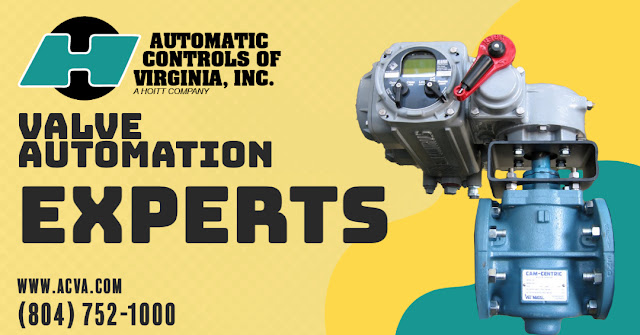An informational blog dedicated to the application of industrial controls, valves and valve automation in the municipal, environmental and industrial markets. This resource will provide educational information in the form of new product introductions, application notes, and basic concepts of all things related to instrumentation, process control, industrial valves, valve actuation, and flow control. Courtesy of Automatic Controls of Virginia (ACVA).
Electric Valve Actuators in Municipal Water Facilities and Industrial Process Plants
Automatic Turbine Water Induction Prevention from Questtec Solutions
Why You Should Choose Double Offset Butterfly Valves Over Single Offset
Your Valve Automation Experts
Basics of Electric Valve Actuators
The Val-Matic American-BFV® Butterfly Valve
Opening and Closing Solutions for the Most Demanding Valve Torque and Thrust Applications
- Standard Efficiency and High Efficiency
- Extends Size and Class of Manual Valves
- Fewer Turns to Close/Lower Input Torque
- External Anti-Back Drive - Configurable to Application
- Designed for Submerged Service - Surpasses IP68
- Nearly Zero Backlash for High Resolution Control
- Standard Gear Operators from 5,000 in-lbs. to 16,000,000 in-lbs.
Valves for Municipal Water Distribution, Storage, and Wastewater Treatment
Hydraulic Press Safety and the Role of Pressure Switches
How Does A Hydraulic Press Work?
- An Arbor press uses a narrow range to support the disposal, seating stamping, manufacturing, and repairing of equipment.
- An H Frame press (or four-column) is the standard in many businesses for its versatility. They are used to straighten, bend, shape, stamp, or cut metal objects.
- C Frame press systems are relatively smaller than H frames but maintain similar utility and flexibility in a light yet compact build.
- Custom presses provide solutions for a company’s personal needs and specifications.
- Press brakes clamp and bend sheet metal and plate material.
The Most Common Reasons for Hydraulic System Failure
Hydraulic systems can fail, whether with a custom press or a four-column frame. After a while, presses may begin to show wear and tear in critical areas. Many damages, however, can be avoided with regular maintenance checks and care.
Let's look at five common causes of hydraulic system failure and electric and hydraulic tool safety practices.
1. Poor Maintenance
Maintenance is essential for keeping your hydraulic press operating at peak efficiency. Here are some components and functions to consider during the evaluation:
- Hoses
- Oil leaks
- Ram Speed
- Wire tightness
- Oil temperature
- Electrical Fuses
- Solenoids and relays
- Oil level and particle count
- Hydraulic fittings for tightness
- Coupling and insert for tightness
- Pressure adjustment for the full range
If these functions are not maintained, presses will fail at a high cost. Daily inspection and standard maintenance will extend its service life and, most importantly, keep workers safe.
2. Leaks through pinholes
Pinhole leaks can cause toxic fluid leakage at speeds of up to 600 feet per second. Although they may be difficult to spot at first, pressure switch technology will alert the user of a leak before any visible signs appear. To ensure proper utility, it is still necessary to inspect your hoses during the inspection process.
3. Inadequate Couplings
Improper coupling of low- and high-pressure systems is another dangerous hazard. It is never a good idea for you or your employees to connect a high-pressure pump to a low-pressure system because component, hose, or fitting ruptures can occur.
4. Removal or modification of a component
Servicing a hydraulic system while the machine engine is running is very likely to result in bodily harm or death. Remove no components while the working units are resting on the ground, safety stands, or blocks; always turn off the engine when doing so.
5. A Low and High-Pressure Warning
Workers may be exposed to three types of hazards when removing or adjusting components without first releasing the pressure:
- Burns from hot, high-pressure fluid
- Bruises, cuts, or abrasions from flailing hydraulic lines
- Hydraulic injection of fluid into the skin
To avoid these common mistakes, educate yourself on hydraulic press systems and carefully follow instructions.
With CCS pressure switches, you can protect your hydraulic equipment, personnel and operations.
You and your team can improve productivity, quality, and employee morale by learning more about hydraulic safety precautions. CCS strives to provide high-quality pressure or temperature switches, cutoff switches, and emergency shutdown switches for those working in industrial hydraulics. The pressure switches in the 604P and 6900P series cater specifically to hydraulic applications.
For more information on CCS pressure and temperature switches in Virginia, contact Automatic Controls of Virginia.
Automatic Controls of Virginia
https://acva.com
(804) 752-1000










